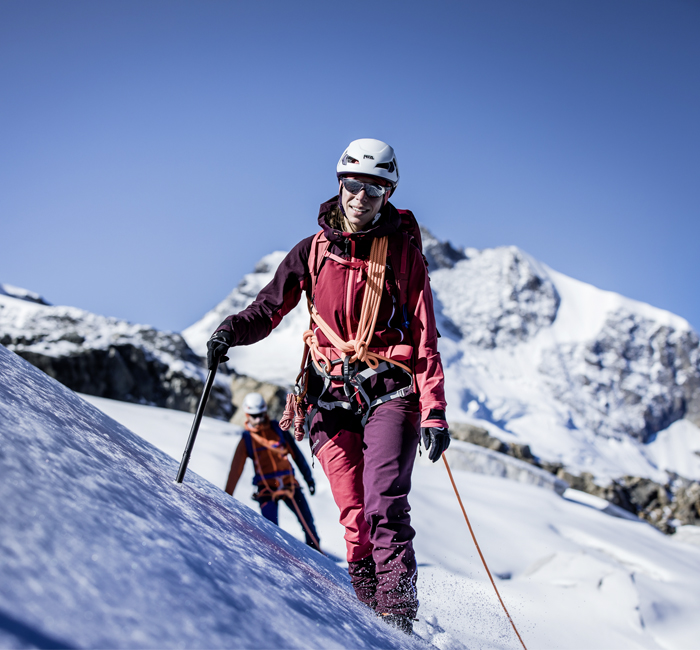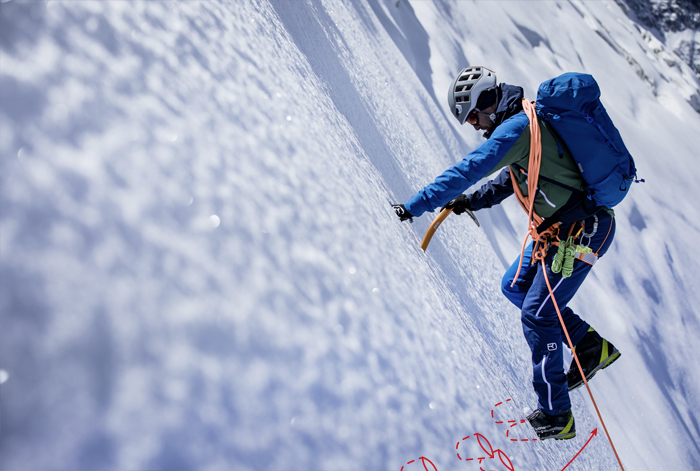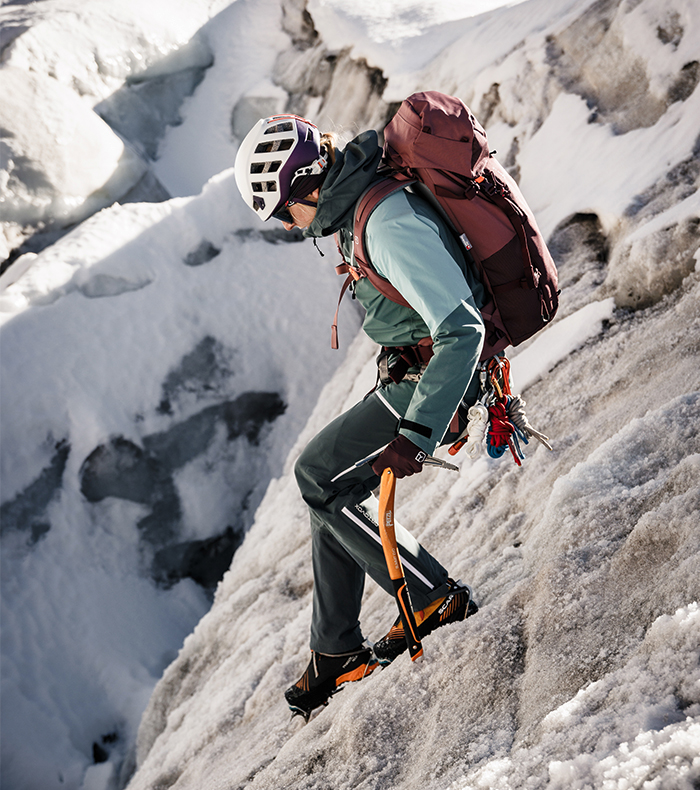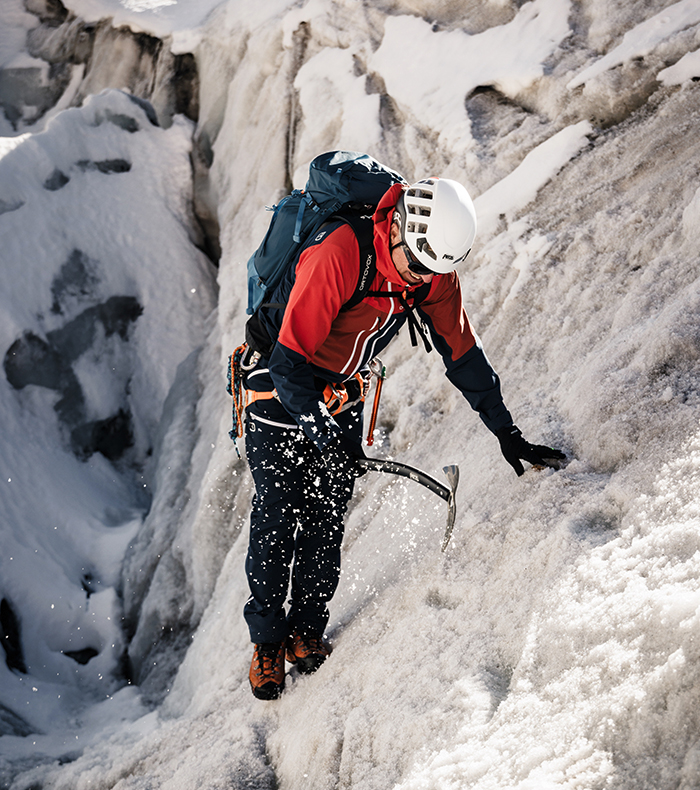To view the content, please accept the necessary cookies.
Video
Walking on a glacier: Firn
Subchapter: Walking techniques
WALKING TECHNIQUES ON ICE AND FIRN
Walking may be a basic human skill – but walking on glaciers is a different matter altogether. A special technique is required, as well as experience in using aids such as an ice axe and crampons. The basic rule is to go without crampons whenever possible. This not only saves energy, it also reduces the risk of injury from a fall. However, when the firn is very hard or has thawed to leave no snow cover but just bare ice, crampons are essential.
HOLDING THE ICE AXE
The “walking stick” technique involves holding an ice axe with the pick pointing to the rear. This means that if you fall, you can grab the ice axe in the self-arrest grip without risking injury from the pick.
ZIGZAG ASCENT ON MODERATE TERRAIN
Depending upon the gradient of the terrain, hardness of the firn, the soles on your boots, walking technique and your own safety awareness, walking on firn is best done without crampons if possible. There are various ways to climb on firn.
In moderately steep terrain, the best approach is to zigzag upwards across the slope. The walking technique used is a scythe-like kicking step, in which you kick footholds in the snow using the side of your boot. The footholds should be slightly inclined towards the slope to prevent slipping. To make walking safe and save energy, kick footholds as deep as possible and take smaller steps. ! You shouldn’t put your weight onto a step until you are sure it’s sufficiently stable.
VERTICAL ASCENT IN STEEP TERRAIN
On steep sections, you climb straight up the face of the slope. Your legs should be hip-wide, upper body upright or bent slightly forwards and your steps should not be too big.
You dig the toe of each boot into the face of the slope, with the heel slightly lower than the toe. This technique is tiring and should only be used over short sections.
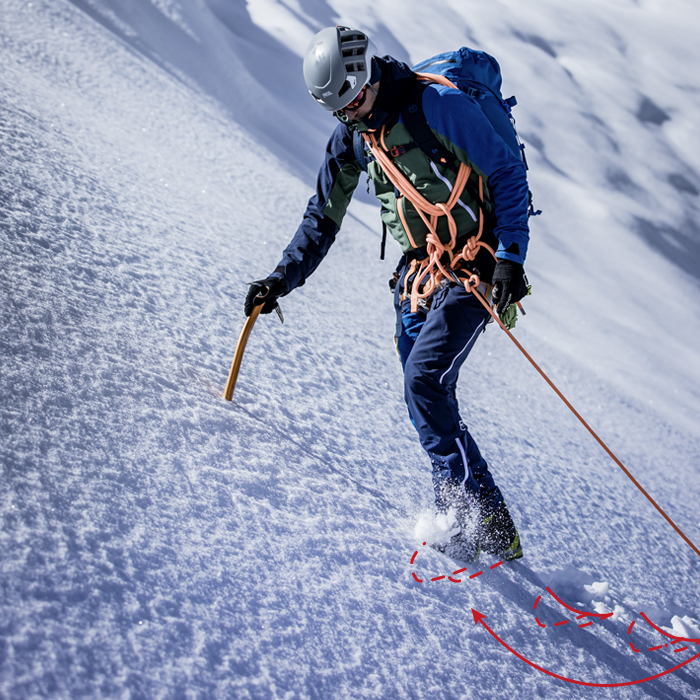
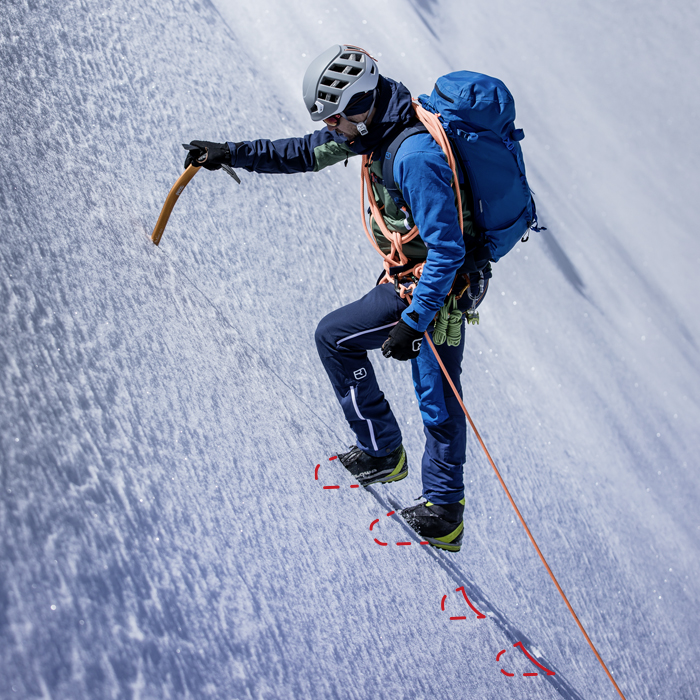
TRAVERSING
You can also use the scythe-like kicking technique to traverse a steep firn slope. As soon as you feel unsafe on an extreme gradient, turn to face the slope and head straight up, kicking steps in the firn with the toe of your boots, bending and straightening legs with each step. Plant the shaft of your ice axe shaft into the slope in front of you for support. This way you’ll be prepared for a potential self-arrest.
DESCENT
It is usually better to descend facing the valley so you can see the terrain. On flatter sections, you should descend with your legs hip-wide and upper body leaning forward, your knees and hips also slightly bent and ready to react if necessary. Use your heels to kick steps in the firn. The distance between steps should be small and each foothold inclined inwards to the slope. Only transfer your weight when you are sure the step is properly formed. Use your ice axe as a support.
Otherwise on steep sections: Similar to a vertical ascent, it is safer here to descend facing the slope, kicking steps in the firn with the toe of your boots. Again, use your ice axe for support.
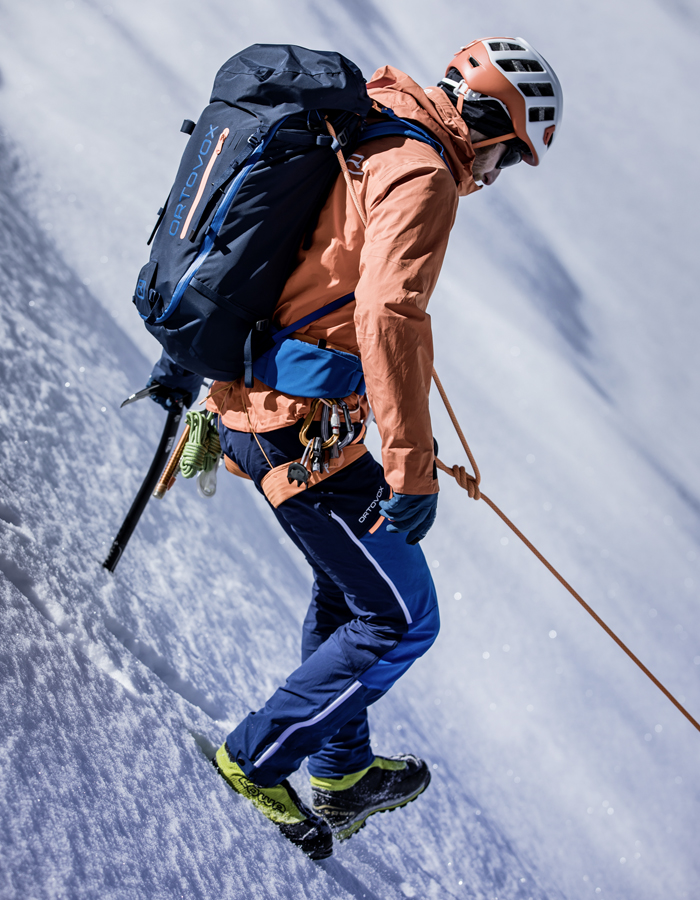
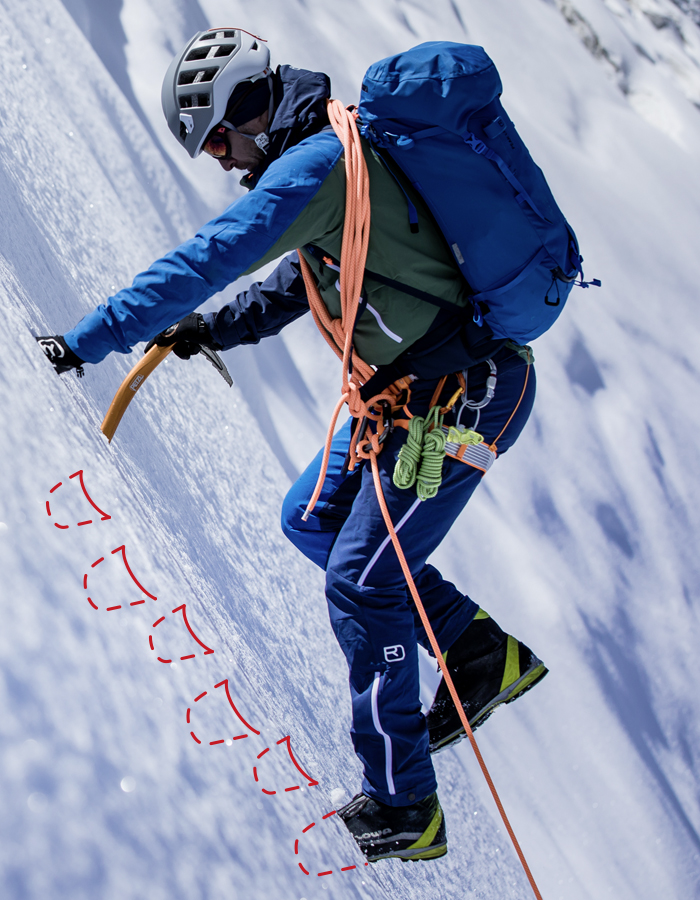
To view the content, please accept the necessary cookies.
Video
Walking on a glacier: On ice
WALKING ON A GLACIER: ON ICE - WITH CRAMPONS
As a general rule: To avoid snagging the crampon on your pant leg, walk with legs apart, leaving a distance between your feet as they pass each other. You should also ensure that your crampons are very firmly attached to your boots.
CLIMBING IN MODERATELY STEEP TERRAIN
In flat to moderately steep terrain up to 35 degrees, use the FLAT-FOOT TECHNIQUE: This involves pressing all points of the crampon evenly into the ice using as much of your body weight as possible. The starting position is feet hip-wide and stable, stepping carefully to avoid crossing legs. In addition, weight transfer from one leg to the other should be very deliberate. Hip, knee and ankle joints should be inclined slightly towards the slope. This permits optimum load placement on the sole of the foot. Use your ice axe as a walking stick on the uphill side for support. Holding the ice axe by the head, plant the spike into the snow. The ice axe shaft will give you support.
CLIMBING IN STEEP TERRAIN
On steep terrain in excess of 35 degrees, use the FRONT POINT TECHNIQUE in combination with your ice axe. This method involves kicking the front points into the ice, if possible into hollows or flatter areas. Your feet should be hip-wide, your steps small, the body upright and your heels slightly lower than your toes, otherwise you may lever the front points out with the toe of your boot. Your feet should be parallel so as to anchor the front points simultaneously. Your knees should be slightly bent. You can use one or two ice axes as support when climbing. Your hand should be placed around the head of the axe, your arm slightly bent. Plant the pick to one side of the upper body as a support. Depending upon the terrain steepness and walking technique, you could also use a basic support axe.
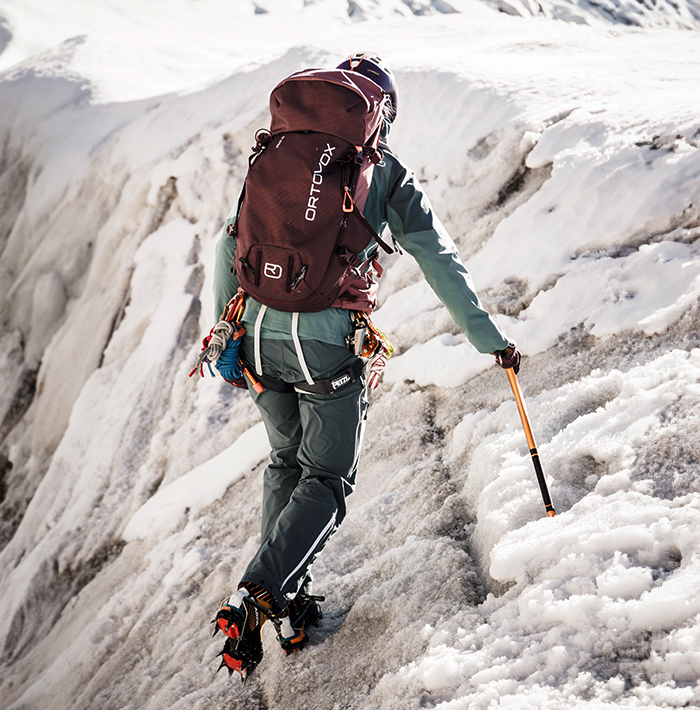
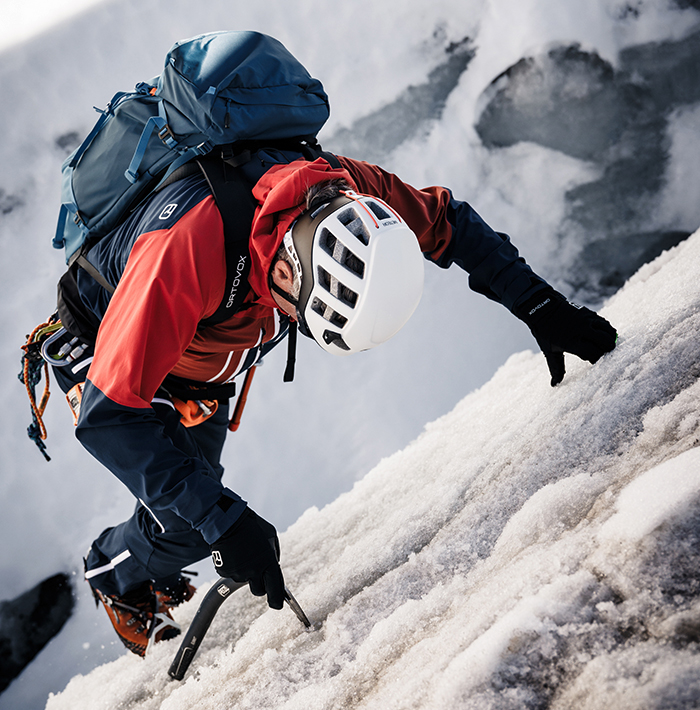
DESCENDING WITH CRAMPONS
When descending over MODERATELY STEEP terrain, your feet should be hip-wide with your face to the valley. The upper body should be bent forwards, knees bent to keep your center of gravity over the crampons to prevent you leaning backwards. Your feet should form a slight V-shape with your ice axe planted in front of your feet.
However, on STEEPER TERRAIN, you should turn around and descend using the front-pointing technique. Before kicking in the crampon, raise the front of the foot slightly so the heel is below the toes. Once placed, the crampon should not be moved until the step has been completed. Use the head of your ice axe for support. Push your ice axe into the snow at hip height, the spike touching the snow.
CUTTING STEPS
You need to know how to cut steps in an energy-conserving way. This is a useful technique for overcoming short steep sections of bare glacier without crampons. The process is similar to chopping wood. Grip the ice axe at the end of the shaft, either one-handed or two-handed, and drive the pick hard into the ice.
When ascending, make the base of the step first, then chop away the ice from above. When descending, start by making the step from above, chopping alternately from left and right and only making the base of the step once you have cleared away enough ice. The step should be neat and angled into the slope.

